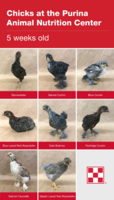Chickens are very sweet animals. Here are the steps to raise chickens:
1. Getting Started
Be sure you have a huge box with bedding in it. Put in a bedding (I used pine shavings), you may want to use towels the first few days because they tend to eat pine shaving, or any other wood shaving; eating pine shavings can lead to pasty butt (to get ride of pasty butt use a towel with warm water and gently rub the area until it is gone), get a feeder and a water jug for your chickens (if you don't have time, cut a hole in a water jug for both the food and water), buy food and water and go buy your chickens!
Brooder Set Up
2. Feathering
Your chickens should be fully feathered at 6 weeks. You will not need a heat lamp for them at this time.
3. Outside
You can let your chickens outside at 3 weeks, if you live in a area with hawks and predators keep a watchful eye on them. If you already have a coop, by 4 weeks you can keep them in the run all day and bring them back at night.
4. Sexing
There are many ways of sexing. You can only really tell the sex of your chicken from 6-8 weeks. 1) The comb and the wattle will be bigger and redder if your chick is a male. 2) Behavior; If your chicken jumps on others or is bossy, it may be a male. Read my article on how to sex a chicken https://www.backyardchickens.com/articles/chicken-sexing.75789/.
5. Treats
At 8 weeks you can start feeding you chicks almost any fruit and vegetable. You can also feed your chicken a few mealworms, and a small amount of oats (your chicken could get sour crop of you feed her to much) Read my article about chicken treats https://www.backyardchickens.com/articles/chicken-treats.75788/
6. What chickens can NOT eat
- Avocadoes (mainly the pit and peel) As with most of the things on this list, I was able to find several people who report feeding avocado to their flock without problem. ...
- Chocolate or Candy. ...
- Citrus. ...
- Green Potato Skins. ...
- Dry Beans. ...
- Junk Food. ...
- Moldy or Rotten Food.
7. Pasty Butt
Pasty butt is very common in chicks, it occurs when they eat shaving (pine, saw) and their poop gets hard. You can get rid of pasty butt by putting your chick near a warm area (so she/he doesn't get a cold) and wetting a towel with warm water. Gently rub the feces until it starts to go away (it may take awhile, don't get frustrated) Read my article on pasty butt https://www.backyardchickens.com/articles/pasty-butt.75786/
8. Sour Crop
Sour crop occurs either when a chicken has worms, or they ate to much of a starchy food, the chicken can't empty its stomach out and it starts growing yeast. The chicken will not get any nutrients from her/ his food. You can check if your chicken has sour crop by feeling the area and massaging itm if she makes a beer like burp she has it. There are many ways to get ride of it, one is to make her vomit it up (it may be dangerous) and the other is separate her from her flock and only give her water for 24 hrs or until the crop gets smaller, then give her 3 small meals a day (her normal food, grit and scrambled eggs), for 2 days. She needs water so you may have to force her to drink it ( hold her water and her beak and but a couple of drops from a syringe into her mouth) Another way is to not give her water and food for 24 hrs and separate her. Massage her crop every hr, the next day add the water back in but not the food. Then on the second day give her 3 small meals a day (her normal food, grit and scrambled eggs), for 2 days. Add her back to her flock and give her food. Read my article on sour crop https://www.backyardchickens.com/articles/sour-crop.75785/gallery
9. How to introduce them to the coop
Having spent their entire lives in a cozy brooder, the members of your young flock might stress out when suddenly confronted with so much open space. Ease your birds into their new area slowly, starting with a one-hour test on a sunny afternoon. Bring out their feeder and waterer so they can drink and eat from something familiar. Step away when you sense that your reassuring presence is no longer needed, but stay nearby just in case. Slowly increase their time in the run until they are happily spending four or five hours outside. At this point, open the coop pop door, allowing the young chickens to discover it on their own. Continue building up the flock’s time in the run and coop, but moving the feeder and waterer to their designated spots inside the coop. You might have to bring a chick or two over and dip their beaks into the water to spread the word that everything’s inside now. Eventually, your little birds will return to the brooder only to sleep, until the day that they all decide to roost on the perch inside their coop.
Enjoy your new chickens!
 Tell me in the comments how it goes!
Tell me in the comments how it goes! 
Don't forget to hit that like button!!
And leave a good review!
Also don't froget to comment

